In mathematics, functions are fundamental tools that describe relationships between inputs and outputs. Think of a function like a machine: you feed it an input, and it processes it to produce a unique output. Understanding the domain and range of a function is crucial for grasping its behavior and applications. The domain defines all possible inputs you can feed into the function without causing it to break down, while the range encompasses all possible outputs the function can produce. This guide will provide a comprehensive explanation of how to find the domain and range of various types of functions, ensuring you have a solid understanding of these core concepts.
Understanding Domain and Range
To properly learn how to find the domain and range of a function, let’s first define what these terms mean in the context of functions.
Domain of a Function
The domain of a function is the set of all possible input values (often referred to as ‘x’ values) for which the function is defined and produces a real number output. Essentially, it’s the collection of all “valid” inputs that you can plug into the function without encountering any mathematical impossibilities, such as division by zero or taking the square root of a negative number. Mathematically, we represent the domain as Domain(f) or simply D(f).
Think of it this way: if a function is a recipe, the domain is the list of ingredients you can use.
Range of a Function
The range of a function is the set of all possible output values (often referred to as ‘y’ values or f(x) values) that the function can produce when you input all possible values from its domain. It represents the set of all achievable results from the function. Mathematically, we represent the range as Range(f) or R(f).
Using the recipe analogy, the range would be the list of all possible dishes you can make using only the allowed ingredients (domain) and following the recipe (function).
We can visualize domain and range with a simple diagram:
In this diagram, the Domain is the set of ‘x’ values that are fed into the function ‘f’, and the Range is the set of ‘y’ values that come out as a result of applying the function to the ‘x’ values.
How to Determine the Domain of a Function
Finding the domain involves identifying any restrictions on the input values that would make the function undefined. Common restrictions arise from:
- Division by Zero: The denominator of a fraction cannot be zero.
- Square Root of a Negative Number: In the real number system, you cannot take the square root of a negative number.
- Logarithm of a Non-Positive Number: The argument of a logarithm must be positive.
Let’s explore the rules for finding the domain for different types of functions:
Rules for Finding the Domain of a Function
| Function Type | Restriction | How to Find the Domain | Example |
|---|---|---|---|
| Polynomial Function | None | The domain is all real numbers (ℝ) or (-∞, ∞). | f(x) = 3x² + 2x – 1 |
| Rational Function | Denominator cannot be zero | Set the denominator ≠ 0 and solve for x. Exclude these x-values from the domain. | f(x) = 1 / (x – 2) |
| Square Root Function | Expression under the square root must be ≥ 0 | Set the expression inside the square root ≥ 0 and solve the inequality for x. | f(x) = √(x + 4) |
| Logarithmic Function | Argument of the logarithm must be > 0 | Set the argument of the logarithm > 0 and solve the inequality for x. | f(x) = ln(x – 1) |
| Absolute Value Function | None | The domain is all real numbers (ℝ) or (-∞, ∞). | f(x) = |
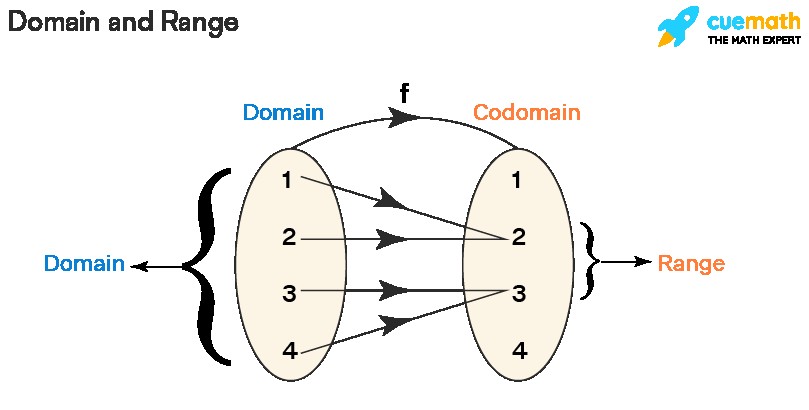
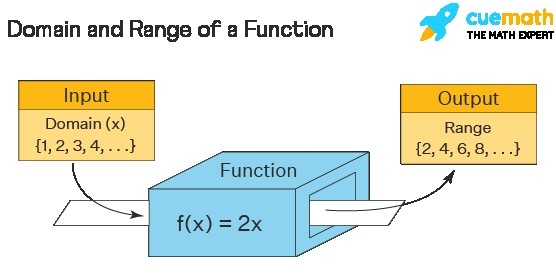
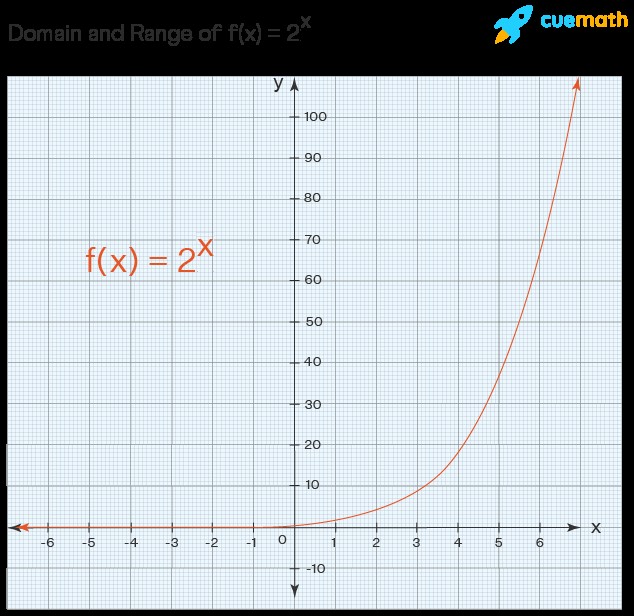
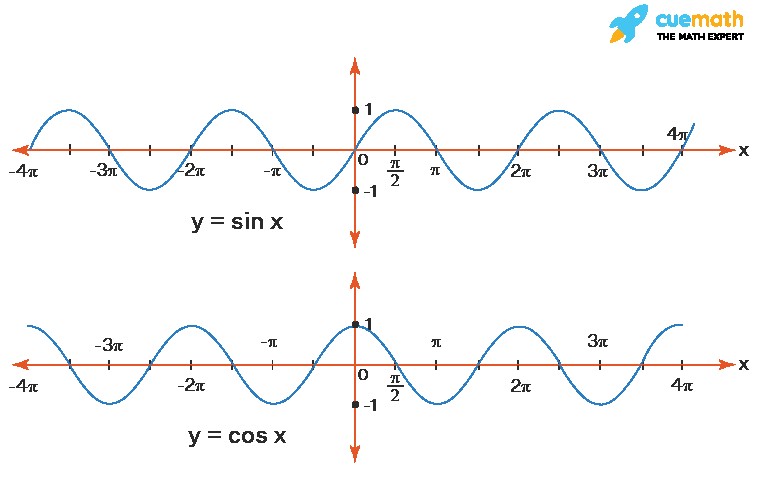
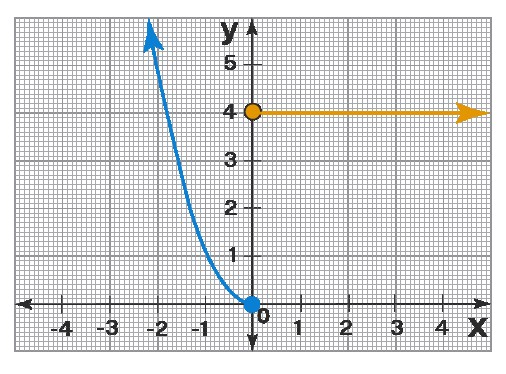

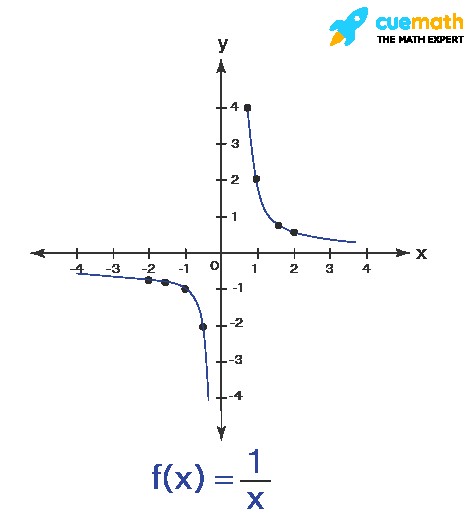
Let’s look at some examples to illustrate these rules:
Example 1: Domain of a Square Root Function
Find the domain of the function f(x) = √(x + 3).
To find the domain, we need to ensure that the expression under the square root is non-negative:
x + 3 ≥ 0
Solving this inequality, we get:
x ≥ -3
Therefore, the domain of f(x) = √(x + 3) is all real numbers greater than or equal to -3. In interval notation, this is [-3, ∞).
Example 2: Domain of a Rational Function
Find the domain of the function g(x) = (2x + 1) / (x – 2).
For this rational function, the denominator cannot be zero:
x – 2 ≠ 0
Solving for x, we get:
x ≠ 2
Thus, the domain of g(x) is all real numbers except 2. In interval notation, this is (-∞, 2) ∪ (2, ∞).
How to Determine the Range of a Function
Finding the range of a function can be more complex than finding the domain. There isn’t a single set of rules that applies to all functions, but here are some common methods and rules for certain types of functions:
Methods for Finding the Range of a Function
-
Graphing: The most visual way to find the range is to graph the function. The range is the set of all y-values that the graph covers. You look at the vertical extent of the graph.
-
Analytical Methods:
- Using Rules for Specific Function Types: Certain types of functions have predictable ranges.
- Solving for x in terms of y: If you can solve the function equation for x in terms of y, then the domain of this ‘inverse relation’ (where y is the input and x is the output) can give you insights into the range of the original function. Specifically, any restrictions on y in this inverse relation will correspond to restrictions on the range of the original function.
Rules for Finding the Range of Common Functions
| Function Type | Range | Example |
|---|---|---|
| Linear Function | All real numbers (ℝ) or (-∞, ∞). | f(x) = 2x + 1 |
| Quadratic Function | For y = a(x – h)² + k: If a > 0, range is [k, ∞). If a < 0, range is (-∞, k]. (k is the y-coordinate of the vertex). | f(x) = -2(x + 1)² + 3 |
| Square Root Function | For f(x) = √(expression), the range is all non-negative real numbers [0, ∞), assuming there are no vertical shifts or reflections. | f(x) = √(x – 2) |
| Exponential Function | For y = ax (a > 0, a ≠ 1), the range is all positive real numbers (0, ∞). | f(x) = 3x |
| Logarithmic Function | For y = loga(x) (a > 0, a ≠ 1), the range is all real numbers (ℝ) or (-∞, ∞). | f(x) = log₂(x) |
| Absolute Value Function | For f(x) = | expression |
| Sine Function (sin x) | [-1, 1] | f(x) = sin(x) |
| Cosine Function (cos x) | [-1, 1] | f(x) = cos(x) |
Example 1: Range of a Quadratic Function
Find the range of the function f(x) = 2(x – 3)² – 5.
This is a quadratic function in vertex form, y = a(x – h)² + k, where a = 2, h = 3, and k = -5. Since a = 2 > 0, the parabola opens upwards, and the vertex (3, -5) represents the minimum point. Therefore, the range is all y-values greater than or equal to -5. In interval notation, the range is [-5, ∞).
Example 2: Range of a Logarithmic Function
Find the range of the function g(x) = ln(2x – 3) + 4.
The basic logarithmic function ln(x) has a range of all real numbers. Transformations like horizontal shifts, stretches, or vertical shifts do not change the range of a logarithmic function. Therefore, the range of g(x) = ln(2x – 3) + 4 is also all real numbers (ℝ) or (-∞, ∞).
Calculating Domain and Range with Sets
Sometimes, the domain and range are explicitly restricted to specific sets. Let’s consider an example:
Let X = {1, 2, 3, 4, 5} and Y = {1, 2, 3, 4, 5, 6}. Consider the function f: X → Y defined by f(x) = x + 1.
-
Domain: The domain is explicitly given as set X, which is {1, 2, 3, 4, 5}.
-
Range: To find the range, we apply the function to each element in the domain:
- f(1) = 1 + 1 = 2
- f(2) = 2 + 1 = 3
- f(3) = 3 + 1 = 4
- f(4) = 4 + 1 = 5
- f(5) = 5 + 1 = 6
Thus, the range is {2, 3, 4, 5, 6}. Note that Y is the codomain, which is the set where the range values could fall, but the range is the set of actual output values achieved by the function.
Domain and Range of Specific Function Types
Let’s examine the domain and range of some key function types in more detail:
Domain and Range of Exponential Functions
Exponential functions, typically in the form y = ax (where a > 0 and a ≠ 1), have a distinct domain and range:
- Domain: Exponential functions are defined for all real numbers. Domain = ℝ = (-∞, ∞).
- Range: Exponential functions always produce positive values. Range = (0, ∞). The function approaches 0 as x approaches -∞, but never actually reaches 0.
Domain and Range of Trigonometric Functions
Trigonometric functions like sine (sin x) and cosine (cos x) also have specific domains and ranges:
- Sine Function (sin x) and Cosine Function (cos x):
- Domain: Both sine and cosine functions are defined for all real numbers. Domain = ℝ = (-∞, ∞).
- Range: The values of both sine and cosine functions oscillate between -1 and 1, inclusive. Range = [-1, 1].
For other trigonometric functions, the domains and ranges differ due to asymptotes and different behaviors:
| Trigonometric Function | Domain | Range |
|---|---|---|
| sin θ | (-∞, +∞) | [-1, +1] |
| cos θ | (-∞, +∞) | [-1, +1] |
| tan θ | ℝ – {(2n + 1)π/2, n ∈ ℤ} | (-∞, +∞) |
| cot θ | ℝ – {nπ, n ∈ ℤ} | (-∞, +∞) |
| sec θ | ℝ – {(2n + 1)π/2, n ∈ ℤ} | (-∞, -1] ∪ [+1, +∞) |
| cosec θ | ℝ – {nπ, n ∈ ℤ} | (-∞, -1] ∪ [+1, +∞) |
Domain and Range of Absolute Value Functions
Absolute value functions, in the form y = |ax + b|, have the following domain and range:
- Domain: Absolute value functions are defined for all real numbers. Domain = ℝ = (-∞, ∞).
- Range: The absolute value of any real number is always non-negative. Range = [0, ∞).
Example: Domain and Range of an Absolute Value Function
Find the domain and range of f(x) = |6 – x|.
- Domain: The domain is all real numbers, ℝ.
- Range: The range is all non-negative real numbers, [0, ∞).
Domain and Range of Square Root Functions
Square root functions, in the form f(x) = √(ax + b), have restrictions on the domain due to the square root of negative numbers:
- Domain: The expression inside the square root must be non-negative: ax + b ≥ 0. Solve for x to find the domain.
- Range: The square root of a non-negative number is always non-negative. Range = [0, ∞), assuming no vertical transformations.
Example: Domain and Range of a Square Root Function
Find the domain and range of h(x) = 2 – √(-3x + 2).
- Domain: -3x + 2 ≥ 0 => -3x ≥ -2 => x ≤ 2/3. Domain = (-∞, 2/3].
- Range: √(-3x + 2) ≥ 0. Then -√(-3x + 2) ≤ 0. Finally, 2 – √(-3x + 2) ≤ 2. Range = (-∞, 2].
Finding Domain and Range From a Graph
Reading domain and range directly from a graph is a valuable skill.
- Domain from Graph: Look at the x-axis. The domain is the set of all x-values for which there is a corresponding point on the graph. Project the graph onto the x-axis.
- Range from Graph: Look at the y-axis. The range is the set of all y-values for which there is a corresponding point on the graph. Project the graph onto the y-axis.
Important Considerations when Reading Graphs:
- Vertical Line Test: Ensure the graph represents a function by verifying it passes the vertical line test (no vertical line intersects the graph more than once).
- Holes: Open circles (holes) on the graph indicate points that are excluded from the domain and/or range.
- Asymptotes: Vertical asymptotes indicate x-values excluded from the domain. Horizontal asymptotes can indicate values that the range approaches but may not include.
- Arrows: Arrows at the end of a graph indicate that it extends infinitely in that direction, implying the domain or range extends to infinity.
- Piecewise Functions: For piecewise functions, consider each piece separately when determining the overall domain and range, and then combine the results using the union symbol (∪).
Example 1: Domain and Range from a Graph
- Domain: The graph extends horizontally from -∞ to ∞. Domain = (-∞, ∞).
- Range: The graph starts at y = 0 and extends upwards to ∞. Range = [0, ∞).
Example 2: Domain and Range from a Graph
- Domain: The graph starts at x = -5 (inclusive) and extends to ∞. Domain = [-5, ∞).
- Range: The graph extends downwards from y = 5 (inclusive) to -∞. Range = (-∞, 5].
Examples on Domain and Range
Example 1: Find the domain and range of f(x) = √(x – 1).
Solution:
- Domain: For the square root to be defined, x – 1 ≥ 0, so x ≥ 1. Domain = [1, ∞).
- Range: The square root function always produces non-negative values. Range = [0, ∞).
Example 2: Find the domain and range of f(x) = 1/x.
Solution:
- Domain: The denominator cannot be zero, so x ≠ 0. Domain = (-∞, 0) ∪ (0, ∞).
- Range: As x approaches 0, y approaches ±∞. As x approaches ±∞, y approaches 0. The function can take any y-value except 0. Range = (-∞, 0) ∪ (0, ∞).
Example 3: Find the domain and range of y = (x + 1) / (3 – x).
Solution:
-
Domain: The denominator cannot be zero, so 3 – x ≠ 0, which means x ≠ 3. Domain = (-∞, 3) ∪ (3, ∞).
-
Range: To find the range, solve for x in terms of y:
y = (x + 1) / (3 – x)
y(3 – x) = x + 1
3y – xy = x + 1
3y – 1 = x + xy
3y – 1 = x(1 + y)
x = (3y – 1) / (1 + y)The denominator in the expression for x cannot be zero, so 1 + y ≠ 0, which means y ≠ -1. Range = (-∞, -1) ∪ (-1, ∞).
Frequently Asked Questions (FAQs)
What are the domain and range of a function?
The domain is the set of all possible input values (x-values) for which the function is defined, and the range is the set of all possible output values (y-values) that the function can produce.
How do you write the domain and range?
Domain and range are typically written in set notation or interval notation. Interval notation uses parentheses for open intervals (excluding endpoints) and square brackets for closed intervals (including endpoints). For example, (-∞, 5] represents all real numbers less than or equal to 5.
How to find domain and range from a graph?
To find the domain from a graph, look at the projection of the graph onto the x-axis. To find the range, look at the projection of the graph onto the y-axis.
What are the domain and range of a constant function?
For a constant function f(x) = k (where k is a constant), the domain is all real numbers (ℝ), and the range is just the single value {k}.
What is the definition of domain in math?
In mathematics, the domain of a function is the set of all possible input values that can be provided to the function without causing it to be undefined or to produce non-real number outputs.
How to find the domain of a rational function?
To find the domain of a rational function (a fraction where the numerator and denominator are polynomials), set the denominator not equal to zero and solve for x. The domain is all real numbers except those values of x that make the denominator zero.
What are the rules to find the domain of a function?
Key rules for finding the domain include:
- For polynomial functions, the domain is all real numbers.
- For rational functions, exclude values that make the denominator zero.
- For square root functions, ensure the expression under the radical is non-negative.
- For logarithmic functions, ensure the argument is positive.
How To Find Domain And Range Of A Function generally?
To find the domain, identify any restrictions on input values (division by zero, even roots of negative numbers, etc.). To find the range, consider graphing the function or using analytical methods to determine the set of all possible output values.
How to find the range of a rational function?
One approach is to solve the rational function equation for x in terms of y. Then, identify any restrictions on y that would make x undefined (e.g., division by zero in the expression for x).
How to find domain and range of an equation?
If you have an equation y = f(x), the domain is the set of permissible x-values, and the range is the set of resulting y-values. To find the domain and range, analyze the function for restrictions or solve for x in terms of y to help determine the range.
How to calculate the domain and range from the graph of a function?
Project the graph onto the x-axis to determine the domain (x-values covered) and onto the y-axis to determine the range (y-values covered).
What is the difference between domain and range of a function?
The domain is about the possible inputs, while the range is about the resulting outputs. The domain is what you can put into the function, and the range is what you get out.
What are the domain and range of a relation?
For a relation (a set of ordered pairs), the domain is the set of all first elements (x-coordinates), and the range is the set of all second elements (y-coordinates) of the ordered pairs.
What are the domain and range of composite functions?
For a composite function like h(x) = f(g(x)), the domain is restricted by both g(x) and f(x). The input x must be in the domain of g, and g(x) must be in the domain of f. The range of h is a subset of the range of f.
What are the domain and range of a quadratic function?
For a quadratic function y = a(x – h)² + k, the domain is all real numbers (ℝ). The range depends on whether the parabola opens upwards (a > 0, range is [k, ∞)) or downwards (a < 0, range is (-∞, k]).
How to find the range of a graph?
To find the range from a graph, look at the y-axis and identify all the y-values that the graph covers vertically. The lowest and highest y-values on the graph will define the range.
Understanding how to find the domain and range of a function is a fundamental skill in mathematics. By mastering these concepts and techniques, you will gain a deeper insight into the behavior of functions and be better equipped to solve a wide range of mathematical problems.